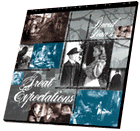

UK drama
1946
bw 118 min.
Director: David Lean
CLV: $49.95 - available
1 disc, catalog # CC1414L
DVD: $39.95 - taking pre-orders now
1 disc, catalog # GRE270DVD
It was quite a surprise to learn that David Lean had not read Charles
Dickens' Great Expectations before he embarked on his film version in 1945. The
closeness of the adaptation, the understanding of the characters, make one swear
it was made by an aficionado, for Dickens is part of every English child's
education. Lean was not "well read"--amongst Dickens' works, he claimed
acquaintance only with A Christmas Carol--but like Dickens, he was a born
storyteller.
Lean brought to the project all his experience as a film editor-he
cuts, dovetails, transposes, and simplifies, without betraying the source novel,
though the ending to one of Dickens' most pessimistic works has been somewhat
modified. Lean was also anxious to make a film which would establish him as an
independent artist following his four-film partnership with Noel Coward. Lean
took with him associates from the Coward days: producer Anthony Havelock-Allan;
Ronald Neame, a former cameraman; and production designer John Bryan and
cameraman Guy Green, both of whom won Oscars for their work.
Lean's previous
film was Brief Encounter-a romantic fantasy disguised as a realistic drama. Great
Expectations reveals a director completely free of any stage conventions and
relishing his craft. The opening of the film has been studied for years and is
held up as an exemplar of film editing. But it is also a brilliant synthesis of
location shooting (the pan across the marshes with their lonely gibbets) with a
studio set (graves with a back-projected church and looming sky), in which the
hero, Pip, has his first fateful meeting with the fearsome Magwitch.
Straight
from the first two pages of Dickens, Pip's narration and his description of the
graveyard is so thick with detail that the shock of the criminal is diminished.
It takes a movie, and a visual stylist like Lean, to translate this into
pictures. From the very start, Lean brings Great Expectations close to the horror
film-and the scene has been copied in horror films ever since.
The scenes in Miss
Havisham's decaying petrified and cobwebby house show a similar Gothic concern, a
heightening of Dickens' already vivid description. These scenes also influenced
horror movies, as well as Billy Wilder's Sunset Boulevard, with its embittered
Norma Desmond living in a musty mausoleum and contriving disaster amongst the
emotional lives of the young.
One of the criticisms often levelled at David Lean
is his conservative choice of subjects. In his autobiography, Micheal Powell, for
whom Lean worked as an editor, wrote about Great Expectations and described, with
a hint of condescension, "how difficult it is for young and inexperienced
producers to choose a subject which is both commercial and valid."
But
commercially, Dickens was a shrewd choice by Lean. The film was a big success,
making John Mills and Alec Guinness major stars. And, in Powell's terms, it was
valid. Dickens was appalled by the iniquities of Victorian society; this social
criticism (present in all his novels) obviously survives in the film. But it also
rang true in 1946-the year after the war and the year after Britain had elected a
Labour government sworn to a welfare state in which decent health and education
services would be available to all, not just an elite. The theme of social
mobility which lies at the heart of the film, and its observations on the dignity
of labour (embodied by the blacksmith Joe Gargery) caught the mood of Britain at
the time. Pip's defiance of Miss Havisham came to symbolise Britain's rejection
of Victorian values, which had survived to the start of World War II. One British
critic thought the film showed "accidental Marxism."
Lean would persue these
ideas in his second Dickens adaptation, Oliver Twist (1948) and make them even
more explicit. He would later examine the sexual repression of the Victorian era
in the underrated Madeleine (1950) and, finally, blow a raspberry at it in the
comedy Hobson's Choice (1954).
There was too, perhaps, a personal involvement in
Great Expectations which gives the lie to Lean being a cold, detached technician,
a manipulator of emotions. Like Pip, Lean had serious identity problems. He'd
married a cousin who had borne him a son, whom he helped financially but
otherwise ignored for most of his life. Pip's fortune and misfortune, his sense
of loss and his sense of not belonging, might well have cast a deep level of
understading and a displaced sympathy on Lean's part.
In later years, Lean would
resist making further adaptations of big, bulky, classic novels. After Lawrence
of Arabia (1962), screenwriter Robert Bolt suggested they tackle Joseph Conrad's
Nostromo, an idea which received a frosty response from Lean. "Robert," he wrote,
"it would be really lazy to do an already-written novel. That wouldn't be the
point of our working together." Lean resisted what he saw as a regression, a
return to the days of his Dickens adaptations. He wanted to create a lasting,
original work of art. But he finally gave in and surrendered to an existing
blueprint: They made Doctor Zhivago (1965), Ryan's Daughter (1970, based on
Madame Bovary, another book Lean had not read) and A Passage to India (1984). At
the time of his death in 1991, Lean and Bolt were finally laboring on Nostromo,
which Lean may have considered a weakness.
Fortunately, the partnership of
Dickens and Lean was more than a great strength. It was a marriage made in
heaven.
--Adrian Turner is British film journalist and critic, and the author of books on Billy Wilder,
David Lean, and Hollywood in the '50s.
Index of Films



Buy CLV |
Buy DVD |
View Items |
Checkout
Ordering Information |
Criterion |
Home Vision
|
|
|





